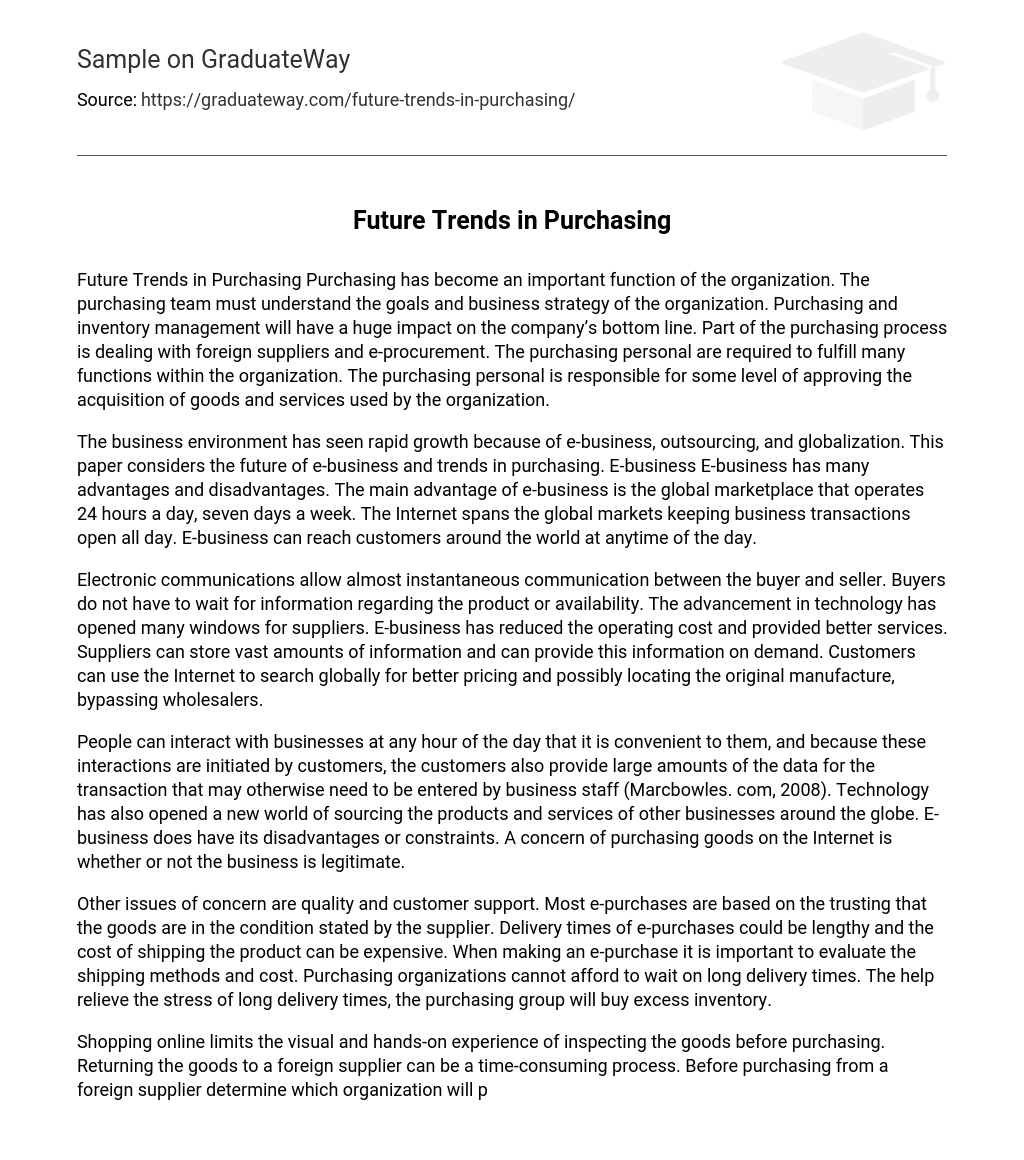Future Trends in Purchasing Purchasing has become an important function of the organization. The purchasing team must understand the goals and business strategy of the organization. Purchasing and inventory management will have a huge impact on the company’s bottom line. Part of the purchasing process is dealing with foreign suppliers and e-procurement. The purchasing personal are required to fulfill many functions within the organization. The purchasing personal is responsible for some level of approving the acquisition of goods and services used by the organization.
The business environment has seen rapid growth because of e-business, outsourcing, and globalization. This paper considers the future of e-business and trends in purchasing. E-business E-business has many advantages and disadvantages. The main advantage of e-business is the global marketplace that operates 24 hours a day, seven days a week. The Internet spans the global markets keeping business transactions open all day. E-business can reach customers around the world at anytime of the day.
Electronic communications allow almost instantaneous communication between the buyer and seller. Buyers do not have to wait for information regarding the product or availability. The advancement in technology has opened many windows for suppliers. E-business has reduced the operating cost and provided better services. Suppliers can store vast amounts of information and can provide this information on demand. Customers can use the Internet to search globally for better pricing and possibly locating the original manufacture, bypassing wholesalers.
People can interact with businesses at any hour of the day that it is convenient to them, and because these interactions are initiated by customers, the customers also provide large amounts of the data for the transaction that may otherwise need to be entered by business staff (Marcbowles. com, 2008). Technology has also opened a new world of sourcing the products and services of other businesses around the globe. E-business does have its disadvantages or constraints. A concern of purchasing goods on the Internet is whether or not the business is legitimate.
Other issues of concern are quality and customer support. Most e-purchases are based on the trusting that the goods are in the condition stated by the supplier. Delivery times of e-purchases could be lengthy and the cost of shipping the product can be expensive. When making an e-purchase it is important to evaluate the shipping methods and cost. Purchasing organizations cannot afford to wait on long delivery times. The help relieve the stress of long delivery times, the purchasing group will buy excess inventory.
Shopping online limits the visual and hands-on experience of inspecting the goods before purchasing. Returning the goods to a foreign supplier can be a time-consuming process. Before purchasing from a foreign supplier determine which organization will pay the cost of returning the goods. Privacy and security are other issues concerning e-purchasing. Credit card payments are a security concern. If misused or identity theft occurs what laws and legal jurisdiction will apply. E-purchasing lacks the human interaction associated with other purchases.
E-business suppliers may lose the importance of customer satisfaction, do not request feed back from customers. Future Opportunities and Trends in Purchasing Organizations are creating purchasing networks. These networks remove the cost of non-competitive processes by joining other organizations and combining purchasing power. The networks allow the buyers to streamline the purchasing process and reduce cost. E-purchasing is becoming more popular in the business world. E-purchasing replaces the time needed to issue a manual purchasing order.
The time-consuming process placing an order and follow up with the supplier is replaced with a few simple clicks. Manually entering a purchase order can cost the organization more than part being ordered. Future Challenges in Purchasing The purchasing personal are being required to fulfill many functions within the organization. The purchasing personal is responsible for some level of approving the acquisition of goods and services used by the organization. The purchasing process includes the ability to negotiate contracts.
Companies are not just looking for the lowest priced supplier, but also suppliers that invest in new technology. The purchasing department must be informed on the purchased goods and finished products. The goal is to find suppliers that help the organization work towards the goal of the company. Procurement software is a must for medium and large organizations. Software must be integrated throughout the organization. A well integrated software system can offer the organization substantial cost savings.
Unfortunately a quality software program can cost up to a million dollars. The purchasing department must be familiar with the purchasing software and take advantage of its benefits. Online catalogs from the major supplies can be stored in the procurement system. The online catalog makes it easier for viewing and ordering supplies. The procurement process consist of several steps, selecting goods, searching for the right supplier, negotiating a price, receiving purchasing approval, ordering the goods, receiving the goods, and paying the invoice.
Companies expect the suppliers to provide quality purchased materials on time. E-purchasing has opened the door to suppliers around the world. Electronic communications allow almost instantaneous communication between the buyer and seller. The Internet has created a new level of purchasing. Buyers can search the Internet for materials and suppliers that will meet the needs of the organization. Reference: Marcbowles. com, 2008: An introduction into e-commerce, Retrieved February 6, 2010 from http://marcbowles. com/sample_courses/amc/ec1/ec1_3. htm





